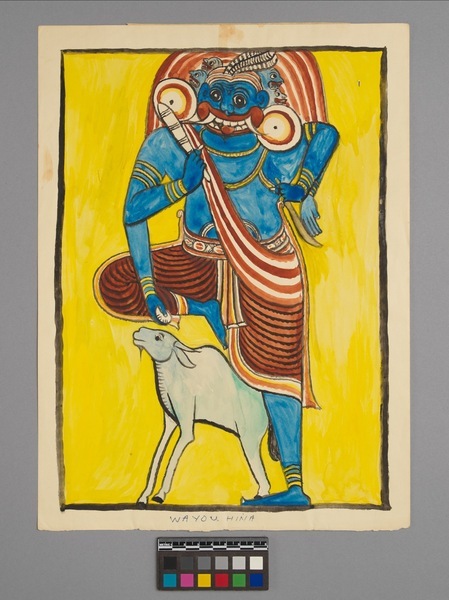Wayou Hina Item Number: 3392/27 from the MOA: University of British Columbia

Description
A watercolour painting which depicts a spiritual being seated on a horned, four legged animal. The being has blue skin, five heads and four arms. It is wearing a brown skirt that ends just below the knee and curls outward at the hip. The bottom of the skirt has a border made up of white, yellow, and brown horizontal stripes. The main body of the skirt is covered in thinner horizontal stripes, and consists of two pieces which come together in the front. A piece of fabric hangs down from the waistband, which is decorated with a pattern of alternating round shapes and diamonds. A brown, striped sash is draped diagonally across the being's chest. Additional adornments wrap around its chest and neck, and decorative bands encircle its biceps, wrists, and ankles. All five of the being's heads have large, round eyes and fanged smiles. The centre head is the largest. It is looking forward, while the four smaller heads look to either side. Long, white and black decorations protrude upwards from the being's headpiece. Two large discs protrude from the sides of its centre head. The being is holding objects in three of its hands, which consist of a small curved blade, a long oblong object with horizontal stripes, and a round object. The being has one knee bent underneath it, which rests on the animal's head and back. The other leg is stretched toward the floor. The animal is light blue, with a humped back, long face and ears, and horns that curve slightly backward. It has a small, pointed beard. The painting's background is yellow, and a rectangular black border surrounds the image. Brown and white oblong rings radiate from the being's head and shoulders.
History Of Use
The imagery is possibly associated with ritual healing in Sri Lanka. The set of watercolours (3392/3-34) is said to depict spirits that inhabit planets, or deviyo (minor gods) or rakshas and yakkas (evil or mischievous beings). These beings are often depicted in masked dances and exorcisms.
Narrative
The collector, Dr. Michael Egan, wrote his doctoral thesis on healing rituals in Sri Lanka. His fieldwork was carried out in the south of Sri Lanka, in the village of Kadurupokuna (Hambantota District), between Sept. 1965 and Nov. 1966.
Item History
- Made in Sri Lanka between 1960 and 1966
- Collected between 1965 and 1966
- Owned by Michael John Egan before 1977
- Owned by Carol Egan before October 2, 2019
- Received from Carol Egan (Donor) on October 2, 2019
What
- Name
- Wayou Hina
- Identification Number
- 3392/27
- Type of Item
- painting
- Overall
- height 37.2 cm, width 27.5 cm
Who
- Culture
- Sinhalese
- Previous Owner
- Michael John Egan and Carol Egan
- Received from
- Carol Egan (Donor)
Where
- Holding Institution
- MOA: University of British Columbia
- Made in
- Sri Lanka
When
- Creation Date
- between 1960 and 1966
- Collection Date
- between 1965 and 1966
- Ownership Date
- before 1977 and before October 2, 2019
- Acquisition Date
- on October 2, 2019
Other
- Item Classes
- paintings; works on paper
- Condition
- good
- Accession Number
- 3392/0027